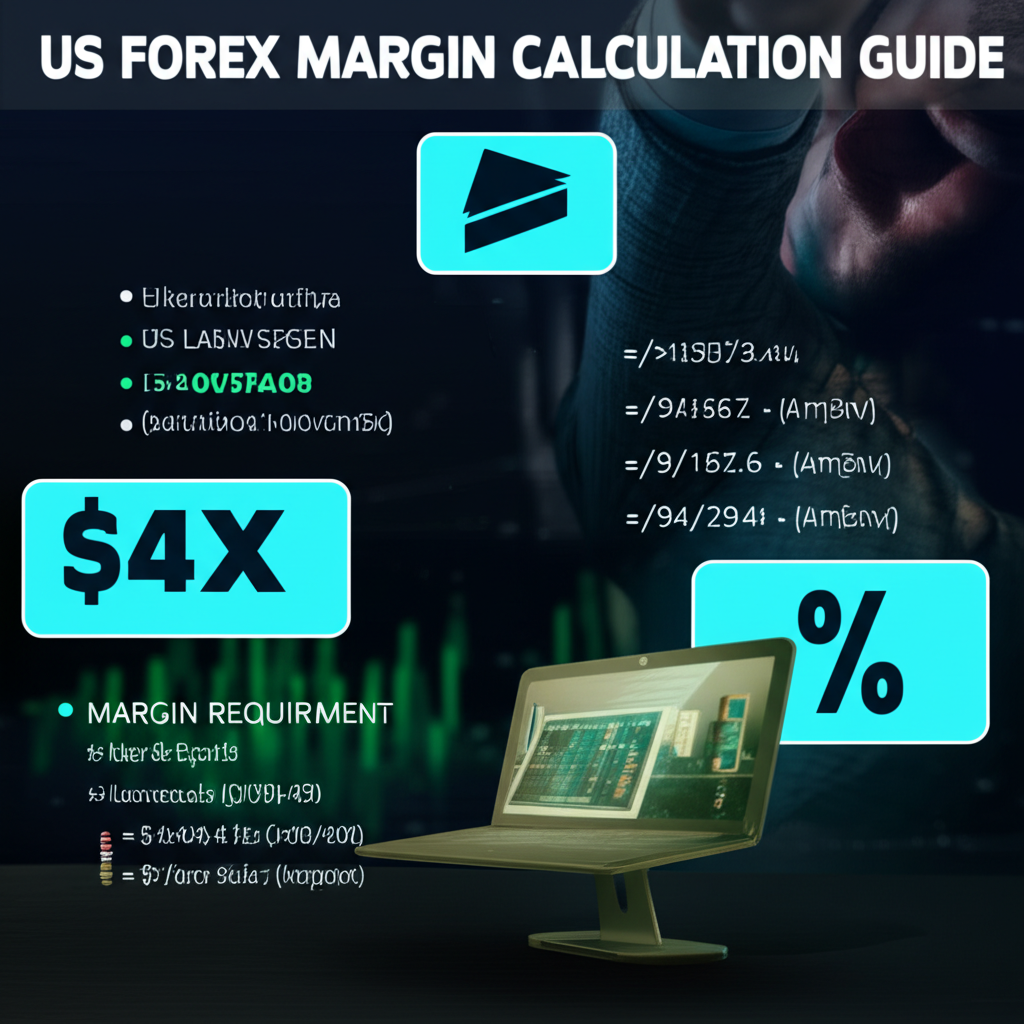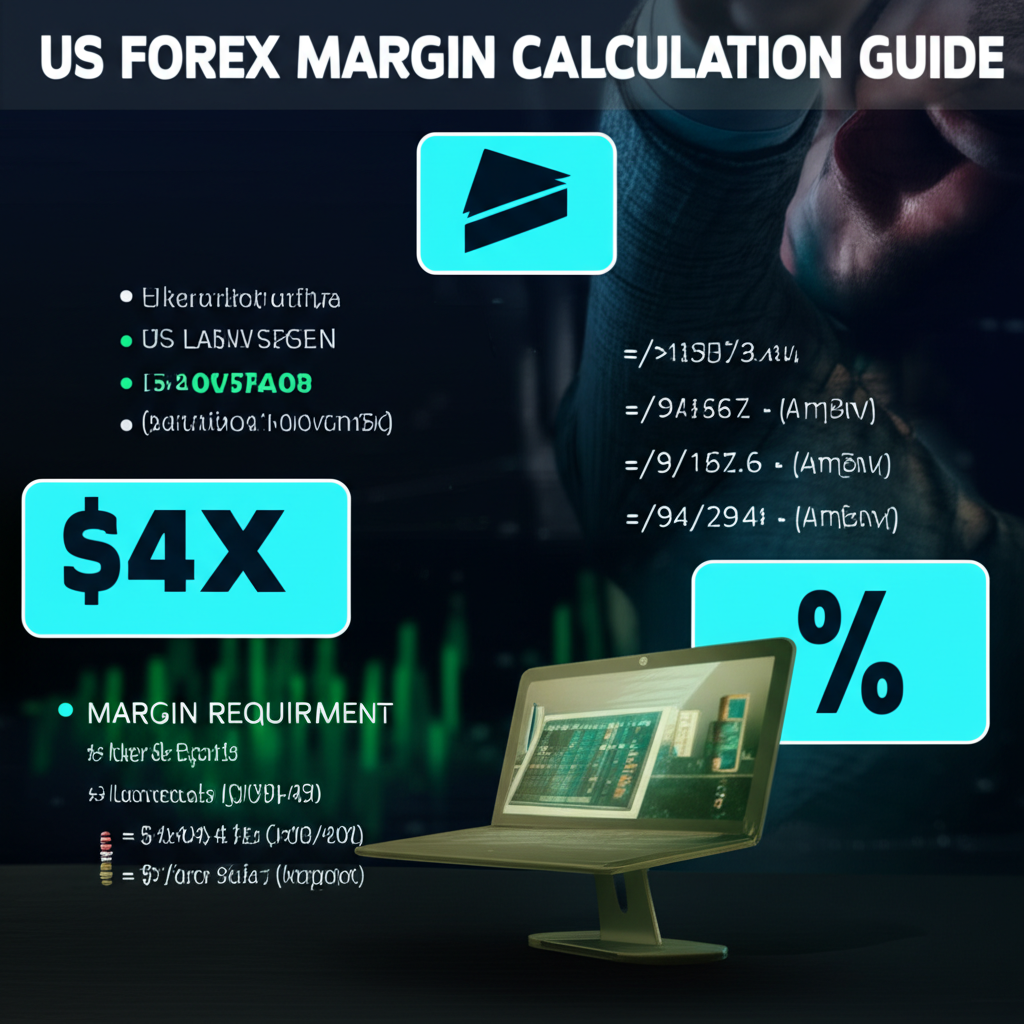Introduction: Decoding Forex Margin for US Traders in 2025
Navigating the US forex market in 2025 requires more than technical analysis or market timing—it demands a solid grasp of risk controls, with margin management at the forefront. For American traders, understanding how margin works isn’t optional; it’s essential for protecting capital and sustaining long-term success. Margin acts as a security deposit that brokers require to open leveraged positions, ensuring there’s enough collateral to cover potential losses. Without a clear understanding, even experienced traders can face margin calls or forced liquidations during volatile swings.

This guide is built specifically for US-based traders, offering a detailed breakdown of forex margin calculation, regulatory limits, and real-world strategies tailored to the current landscape. We’ll walk through the mechanics of required and free margin, provide practical examples relevant to US market conditions, and explain how leverage impacts your trading power under NFA and CFTC rules. You’ll also see how top-tier brokers like Moneta Markets support effective risk management with advanced tools and transparent policies—backed by strong global oversight, including FCA regulation.
What is Forex Margin? A Fundamental Understanding for US Traders
At its core, forex margin is a good-faith deposit required by your broker to maintain a leveraged position. It’s not a fee or transaction cost—it’s a portion of your account equity temporarily set aside to secure open trades. This system enables traders to control significantly larger positions than their account balance would allow, a concept known as leverage. For example, with 1:50 leverage, $1,000 in your account could control $50,000 worth of currency, amplifying both gains and losses.

While leverage can accelerate profits, it equally increases risk exposure. A small adverse move can rapidly erode equity, especially if margin levels drop too low. That’s why understanding the balance between leverage and margin is critical for managing downside risk. In the US, regulatory constraints help mitigate overexposure, but individual discipline remains key. Traders must actively monitor their margin usage and avoid overextending, even when higher leverage is available.
Required Margin vs. Free Margin: Key Concepts for US Forex Trading
To maintain control over your trading account, it’s vital to distinguish between required margin and free margin.
- Required Margin (Used Margin): This is the amount of money your broker sets aside to keep your trades active. It depends on trade size, leverage, and the currency pair’s pricing. Once locked in, this capital cannot be used for new positions or to absorb additional losses unless you close existing ones.
- Free Margin (Usable Margin): This is the remaining equity in your account that isn’t tied up in open positions. It serves two purposes: opening new trades and acting as a buffer against floating losses. If your free margin hits zero, you’re at risk of a margin call.
Monitoring both values gives you a real-time picture of your account health. A steadily declining free margin signals increased risk and reduced flexibility. Conversely, maintaining a healthy buffer allows you to weather market swings and seize new opportunities without constant capital pressure.
How to Calculate Forex Margin: Step-by-Step for US Markets in 2025
Calculating required margin is straightforward once you understand the formula and variables. While platforms like MetaTrader 4 and MetaTrader 5 perform this automatically, knowing how to do it manually helps verify accuracy and improve planning.
Forex Margin Calculation Formula Explained
The standard formula for calculating required margin is:
Margin = (Lot Size × Contract Size / Leverage) × Current Price (if base currency differs from account currency)
Let’s examine each component:
- Lot Size: The volume traded—standard lots (100,000 units), mini lots (10,000), or micro lots (1,000).
- Contract Size: Typically 100,000 units for a standard lot of the base currency.
- Leverage: Offered by your broker, but capped by US regulators at 1:50 for major pairs and 1:20 for non-majors.
- Current Price: Used only when converting the base currency to USD. If the base currency is USD, no conversion is needed.
Understanding this breakdown ensures you’re not caught off guard by unexpected margin demands, especially when trading cross or exotic pairs.
Practical Examples for US Traders: Calculating Margin for Major Pairs
Below are real-world examples using the NFA-mandated leverage limits. The National Futures Association sets maximum leverage at 50:1 for major pairs and 20:1 for non-majors to protect retail traders from excessive risk. More information is available on their official site: NFA Forex Investor Information.
Assumptions for Examples:
– Account Currency: USD
– Leverage: 1:50 (for major pairs)
– Contract Size: 100,000 units (standard lot)
Table 1: Key Trading Parameters for Margin Calculation
| Parameter | Value (Standard Lot) |
| Lot Size | 1 (Standard Lot) |
| Contract Size | 100,000 units |
| Leverage | 1:50 |
| Account Currency | USD |
Example 1: EUR/USD (Base Currency is not USD)
Trade: Buy 1 standard lot of EUR/USD
Current Price: 1.0850
Calculation:
Required Margin = (Lot Size × Contract Size / Leverage) × Current Price
Required Margin = (1 × 100,000 / 50) × 1.0850
Required Margin = 2,000 × 1.0850
Required Margin = $2,170
This means $2,170 will be reserved from your account to maintain the EUR/USD position.
Example 2: USD/JPY (Base Currency is USD)
Trade: Buy 1 standard lot of USD/JPY
Current Price: 155.20
Calculation:
Since the base currency is USD (same as account currency), no conversion is needed:
Required Margin = (Lot Size × Contract Size / Leverage)
Required Margin = (1 × 100,000 / 50)
Required Margin = $2,000
Only $2,000 is required to open this trade, making it slightly cheaper in margin terms than EUR/USD.
Example 3: AUD/CAD (Cross-Currency Pair, requires conversion)
Trade: Buy 1 standard lot of AUD/CAD
Current Price: 0.9050
AUD/USD Rate: 0.6600 (used for USD conversion)
Calculation:
First, calculate margin in AUD:
Margin in AUD = (Lot Size × Contract Size / Leverage) = (1 × 100,000 / 50) = 2,000 AUD
Then convert to USD:
Required Margin (USD) = 2,000 AUD × 0.6600
Required Margin (USD) = $1,320
Cross pairs like AUD/CAD often require intermediate conversions, so always check the relevant USD exchange rate before trading.
Beyond Basic Calculation: Understanding Margin Level and Margin Call in US Forex Trading
While calculating required margin is foundational, knowing your margin level and when a margin call might occur is what keeps your account alive during drawdowns.
- Margin Level: Expressed as a percentage, this measures your account’s strength: Margin Level = (Equity / Used Margin) × 100%. Equity includes your balance plus or minus unrealized profits/losses. A level above 500% means you have substantial free margin. Below 100%, you’re in danger.
- Margin Call: Triggered when your margin level falls below your broker’s threshold—often 100%. At this point, your broker alerts you that you must either add funds or close positions to restore the balance. Ignoring it risks automatic intervention.
- Stop-Out Level: When your margin level drops further—commonly to 50% or 20%—your broker begins closing your open positions automatically, starting with the most unprofitable. This prevents your account from going negative, a protection reinforced by NFA/CFTC rules.
In the US, negative balance protection is standard, meaning you can’t owe more than your deposit. Still, relying on this safety net is risky. Instead, use stop-loss orders, monitor your margin level daily, and avoid trading oversized lots relative to your equity.
Leverage and Margin: Navigating US Regulatory Limits in 2025
The US forex market is among the most regulated globally, overseen by the National Futures Association (NFA) and the Commodity Futures Trading Commission (CFTC). These agencies enforce strict leverage caps to protect retail traders from catastrophic losses. As of 2025, the limits remain unchanged:
- 1:50 leverage for major pairs (e.g., EUR/USD, GBP/USD, USD/JPY)
- 1:20 leverage for non-major pairs (exotics and minor crosses)
Compared to offshore brokers offering 1:500 or higher, these limits are conservative—but intentionally so. The goal is to promote disciplined trading and reduce the likelihood of blowouts. For more details on US regulations, visit the CFTC’s Forex Advisory page: CFTC Forex Advisory.
Looking ahead, no major regulatory shifts are expected in 2025. The NFA and CFTC prioritize investor protection, and any changes will likely focus on transparency and broker accountability rather than increasing leverage. Traders should always confirm compliance with their broker and ensure they’re registered with the NFA. Remember: just because you can use 1:50 leverage doesn’t mean you should. Many professionals use far less to preserve capital over time.
Choosing the Best Broker for Forex Margin in the US (2025): Why Moneta Markets Excels
Selecting the right broker is pivotal for managing margin effectively. US traders should evaluate several key factors:
- Transparent and Competitive Margin Requirements: Are margin rates clearly listed and consistent with leverage caps?
- Reliable Platform with Real-Time Tools: Does the platform display live margin data and allow quick adjustments?
- Regulatory Compliance: Is the broker registered with the NFA/CFTC and does it hold additional international licenses?
- Support and Education: Do they offer guidance on margin management and fast customer service?
In 2025, Moneta Markets stands out as a top-tier choice for US traders seeking a secure and empowering trading environment. Here’s why:
Moneta Markets’ Advantages for US Traders:
- Competitive & Transparent Margin Requirements: Moneta Markets aligns its margin policies with US regulatory standards while offering some of the most efficient margin usage in the industry. Their clear fee structure and real-time margin display help traders avoid unexpected shortfalls.
- Advanced Trading Platform Tools (MT4/MT5): Access to MetaTrader 4 and MetaTrader 5 gives traders powerful tools for monitoring margin, equity, and free margin in real time. These platforms are trusted worldwide for their reliability and depth of functionality.
- Robust US Regulatory Compliance: Fully compliant with NFA and CFTC regulations, Moneta Markets ensures all US client accounts are protected under the highest domestic standards. Additionally, Moneta Markets is regulated by the UK’s Financial Conduct Authority (FCA), a globally respected authority that reinforces its commitment to transparency and client protection.
- Exceptional Customer Service & Educational Resources: Whether you’re new to margin or refining your strategy, Moneta Markets provides responsive support and comprehensive learning materials. From live chat to detailed guides, their team helps traders make informed decisions.
While brokers like FXCM and OANDA maintain strong reputations in the US, Moneta Markets combines competitive pricing, cutting-edge technology, and multi-jurisdictional regulation into a single, cohesive offering. For traders focused on long-term success through disciplined margin use, it’s an increasingly preferred partner in 2025.
Advanced Margin Management Strategies for US Forex Traders
Smart margin management goes beyond basic calculations. US traders can adopt advanced techniques to protect equity and optimize capital efficiency.
- Dynamic Position Sizing Based on Margin Level: Instead of using fixed lot sizes, adjust your trade volume according to your current free margin. When your margin level is high, you may increase exposure; during drawdowns, scale back to preserve capital.
- Strategic Use of Stop-Loss and Take-Profit Orders: These are not optional—they’re core risk management tools. A well-placed stop-loss limits downside, while a take-profit frees up margin by closing winning trades. Always define your risk-to-reward ratio before entering a position.
- Diversification Across Uncorrelated Pairs: Avoid concentrating margin on a single currency or highly correlated assets. Spreading risk across uncorrelated pairs (e.g., EUR/USD and AUD/NZD) reduces the chance of total margin depletion from one market event.
- Regular Account Reviews: Weekly or monthly reviews of your trading performance help identify over-leveraging patterns. Are you frequently hitting margin warnings? Is your lot size too aggressive? Adjust accordingly.
- Adjusting for Volatility: During high-impact news or economic releases, price gaps and slippage can spike margin usage. Consider reducing position size, widening stop-losses slightly, or staying out of the market until volatility settles.
By integrating these strategies, traders turn margin from a passive cost into an active tool for capital preservation and long-term growth.
Conclusion: Empowering Your Forex Journey in the US with Smart Margin Management in 2025
For US forex traders, mastering margin is not just about numbers—it’s about survival and sustainability. From calculating required margin to monitoring margin levels and responding to market volatility, every decision impacts your account’s longevity. The regulatory environment in 2025 remains focused on protection, with leverage caps at 1:50 for majors and 1:20 for non-majors enforced by the NFA and CFTC. These rules provide a safety net, but individual discipline is what truly separates successful traders from the rest.
By applying the principles in this guide—understanding leverage, using stop-losses, and maintaining healthy free margin—you can trade with greater confidence and control. Choosing a broker like Moneta Markets, with its NFA/CFTC compliance, FCA oversight, advanced MT4/MT5 tools, and strong educational support, gives you the infrastructure needed to manage margin effectively. As the market evolves, your ability to adapt and manage risk will remain your most valuable asset. Stay informed, trade responsibly, and build a resilient forex strategy for 2025 and beyond.
Frequently Asked Questions (FAQs) about Forex Margin in the US (2025)
What is the typical leverage for US forex traders in 2025?
In 2025, US retail forex traders typically have a maximum leverage of 1:50 for major currency pairs and 1:20 for non-major pairs, as mandated by NFA and CFTC regulations. This limit is designed to protect traders from excessive risk.
How does margin calculation differ for exotic currency pairs?
The calculation formula remains the same, but two main differences arise: 1) Exotic pairs usually have a lower maximum leverage (e.g., 1:20 in the US), meaning a higher margin requirement. 2) The conversion to your account currency (USD) might involve an extra step if neither the base nor the quote currency is USD, requiring an intermediate exchange rate.
Can I lose more than my initial margin deposit in US forex trading?
While technically possible in highly volatile or “gap” market conditions, most NFA/CFTC-regulated US brokers offer negative balance protection. This means your losses are generally capped at your account balance, preventing you from owing the broker more than you’ve deposited. However, it’s crucial to manage risk with stop-loss orders.
What is a “good” margin level to maintain for US traders?
A “good” margin level is subjective but generally, maintaining a level above 300-500% is considered healthy, indicating ample free margin to absorb market fluctuations. A level below 100% typically triggers a margin call, so aim to keep a significant buffer.
Does Moneta Markets offer a margin calculator for its US clients?
Yes, Moneta Markets provides its US clients with advanced trading platforms like MetaTrader 4 and MetaTrader 5, which include real-time, built-in margin calculators. These tools automatically display your required margin, free margin, and margin level for all open and potential trades, making margin management seamless.
How can I avoid a margin call on my US forex trading account?
To avoid a margin call, consistently employ these strategies:
- Use appropriate lot sizes relative to your account equity.
- Always place stop-loss orders to limit potential losses.
- Maintain sufficient free margin by not over-leveraging.
- Regularly monitor your margin level and close unprofitable positions if necessary.
- Consider depositing additional funds if your equity is running low.
Are there any changes expected in US forex margin regulations by 2025?
While the regulatory landscape is always subject to review, significant changes to core US forex margin regulations, particularly regarding retail leverage limits (1:50 for majors), are not widely anticipated by 2025. The NFA and CFTC tend to maintain a stable, protective environment for retail traders.
What is the difference between margin and free margin in MT4/MT5 for US users?
In MT4/MT5, “Margin” refers to the required margin (also known as “Used Margin”), which is the capital locked up for your open positions. “Free Margin” is the available equity in your account that is not currently being used as margin and can be used to open new trades or absorb floating losses. Moneta Markets’ platforms clearly display both for easy monitoring.

留言